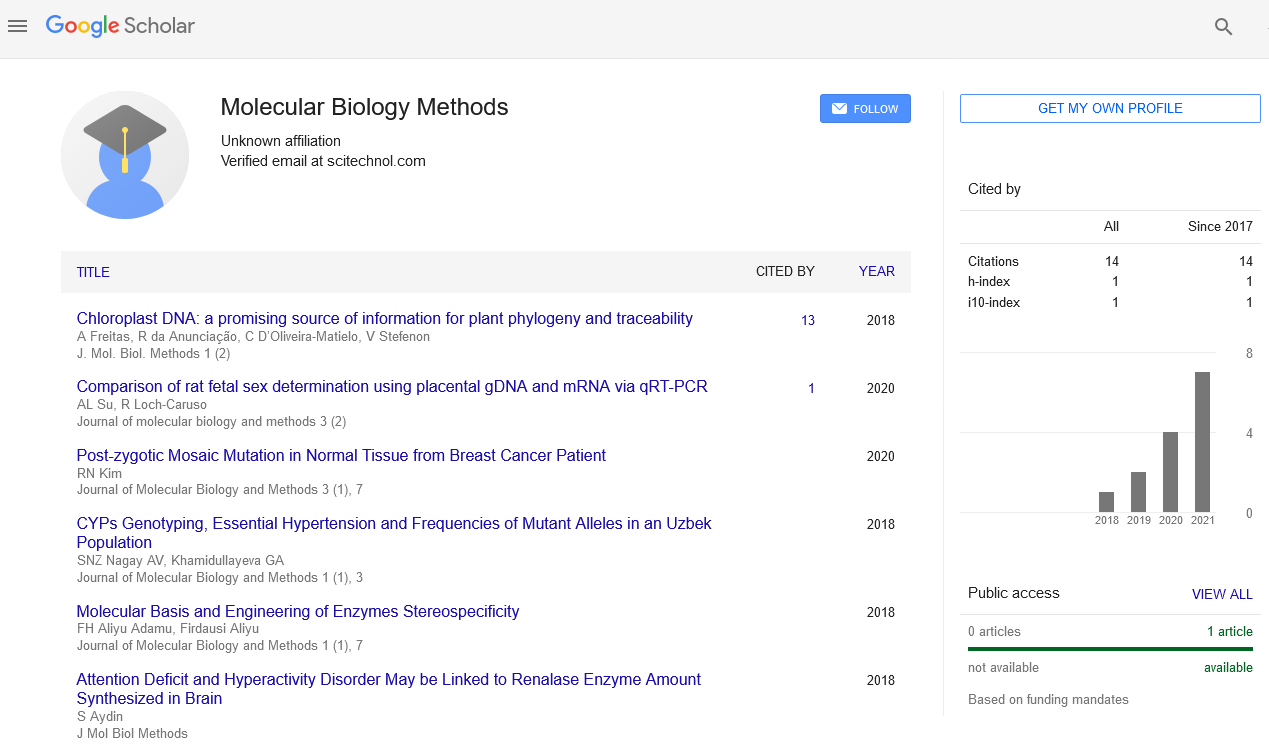Editorial, J Mol Biol Methods Vol: 3 Issue: 1
Attention Deficit and Hyperactivity Disorder May be Linked to Renalase Enzyme Amount Synthesized in Brain?
Suleyman Aydin*
Department of Medical Biochemistry (Firat Hormones Research Group), School of Medicine, Firat University, Elazig, Turkey
*Corresponding Author : Prof. Dr. Suleyman Aydin
Department of Medical Biochemistry (Firat Hormones Research Group), School of Medicine, Firat University, 23119-Elazig, Turkey
Tel: 90 5334934643
E-mail: saydin1@hotmail.com
Citation: Aydin S (2020) Attention Deficit and Hyperactivity Disorder May be Linked to Renalase Enzyme Amount Synthesized in Brain? J Mol Biol Methods 3:1.
Keywords: Hyperactivity Disorder, medicinal biochemistry, Renalase Enzyme
Attention deficit and hyperactivity disorder in children (excessive mobility, attention and concentration deficit, impulsivity) are important health problems that may affect life quality lifelong. Attention deficit generally take place with dyslexia, dyscalculia and dysgraphia which are known generally as specific learning difficulty (SLD) [1]. Principal biochemical mechanism underlying attention deficit and hyperactivity disorder might be related with inadequate synthesizing of dopamine and noradrenalin in brain or rapidly catabolism of these molecules.
Dopamine, noradrenalin (norepinephrine) and epinephrine (adrenalin) molecules are named generally as catecholamines. Catecholomines are synthesized at suprarenal glands and from tyrosine amino acid at nerve system [1,2]. First and principal control enzyme named as tyrosine hydroxylase catalyses the hydroxylation of tyrosine to DOPA (dihydroxyphenyl alanine). Composed DOPA is decarboxylased by DOPA-decarboxylase enzyme which is a cytoplasmic enzyme to dopamine (dihydroxy phenyletylamine). Dopamine is converted to epinephrine through dopamine beta hydroxylase. Epinephrine composed this way is converted to norepinephrine through COMT (cathecol-o-methyltransferase) [1]. There is no recalling mechanism of cathecolamines released at adrenal medulla. Cathecolamine synthesing cells at adrenal medulla are named as “chromaffin cells” because these cells are stained to reddish-brown color with potassium dichromate. Chromaffin cells are also found in heart, liver, kidneys, gonads and adrenergic neurons of postganglionic sympathetic system and in central nerve system [1,3,4].
Based on before mentioned information it is hypothyzed in this editorial that attention deficit and hyperactivity disorder may directly be related to renalase enzyme which is employed in the catalyses of cathecholamines [5,6]. Because renalase enzyme catalyses cathecholamines and catabolizing affinity of this enzyme on cathecholamines is as the order of dopamine epinephrine and norepinephrine [6]. Primary production place of renalase enzyme is at kidneys [5]. But it can be synthesized in various other tissues including brain. Normal amount of this enzyme in biological fluids is stated as 3-5 micrograms/ml [6]. Values above or under this normal range may cause a pathological situation. In such a way that attention deficit and hyperactivity disorder are caused by inadequate synthesis or over-catabolism of catecholamines, dopamine and noradrenaline. If renalase synthesizer cells produce excessive renalase for a reason (for example; depending on hypertrophy), catabolism of cathecolamines in a unit of time increases and this causes dopamine and norepinephrine deficit resulting in attention deficit and hyperactivity disorder. Renalase which is produced by kidneys and other organs is predicted to have no effect on the catabolism of cathecolamines in brain [5,6]. As renalase is a 38 kDA molecule, it is thought that it cannot pass blood-brain barrier [6]. Moreover, if kidneys and other organs produced excessive renalase, all attention deficit and hyperactivity disorder individuals had to be hypotensive. Because it was notified that excessive amount of renalase caused hypotension by degrading cathecholamines [7]. Whereas hypotension is not observed in individuals with attention deficit and hyperactivity disorder. It is highly possible that attention deficit and hyperactivity disorder are related to the degradation of cathecholamines based on excessive production of renalase in brain. It is predicted that attention deficit and hyperactivity disorder can be suppressed by removal of renalase producing part of brain with surgical interference as it inhibits the degradation of cathecholamines. Methylphenidates (Concerta and Ritalin) which are used for the treatment of attention deficit and hyperactivity disorder are the chemicals arranging the amount of dopamine and norepinephrine. It is thought for future researches that the development of brain renalase inhibiting drugs may help to abolish diseases related by Parkinson, attention deficit and hyperactivity disorder.
References
- Minder F, Zuberer A, Brandeis D, Drechsler R (2017) A review of the clinical utility of systematic behavioral observations in attention deficit hyperactivity disorder (ADHD). Child Psychiatry Hum Dev 48: 1-35.
- Fernstrom JD (1977) Effects on the diet on brain neurotransmitters. Metabolism 26: 207-223.
- Fernstrom JD, Fernstrom MH (2007) Tyrosine, phenylalanine, and catecholamine synthesis and function in the brain. J Nutr 137: 1539S-1547S.
- Perlman RL, Chalfie M (1977) Catecholamine release from the adrenal medulla. Clin Endocrinol Meta 6: 551-576.
- Xu J, Li G, Wang P, Velazquez H, Yao X, et al. (2005) Renalase is a novel, soluble monoamine oxidase that regulates cardiac function and blood pressure. J Clin Invest 115: 1275-1280.
- Aydin S, Ugur K, Aydin S (2017) Could pulmonary hypertension be the cause of renalase insufficiency? J Metab 1: 2.
- Aydin S, Aydin S (2017) Can strict control of renalase present a new treatment alternative in regulating blood pressure? J Cardiovasc Med Cardiol 4: 008-009.
 Spanish
Spanish  Chinese
Chinese  Russian
Russian  German
German  French
French  Japanese
Japanese  Portuguese
Portuguese  Hindi
Hindi 